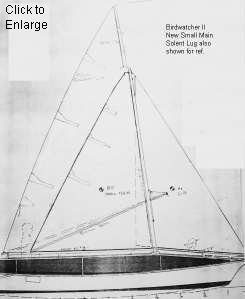My Experience with Sailing the Birdwatcher II
Foreword - The other parts of this story have been pictures of how I followed Phil Bolger's plans to build the boat. All that is changing. This is mostly words about how this guy reacted to the sail design, by building it and testing it on the water, and also, how I strayed from the designer's sail concept to meet my personal needs. Boats are a personal thing, and it would appear to me that sails are even more so. Thus what you read here is what I observe, and not some absolute answer for the Birdwatcher. Think about how you are going to sail the boat, what your expectations are, and details such as how old and strong you are! Then make your own decisions, make sails or have them made, and get out sailing. I need to thank several people that have made excellent suggestions to solve my various sail problems. I hope to not omit anyone, but David Lipsey, John Kohnen, Jack Wyman, Doug "the Oarman", Lou Brochetti and Lynne Fabricant of The Sailmaker's Art have all been most generous with their knowledge. --Bob
The following is an edited log of comments and thoughts as the sail investigation continued. I have, however omitted the details of some ideas that were not used, to keep this from being excessively long.
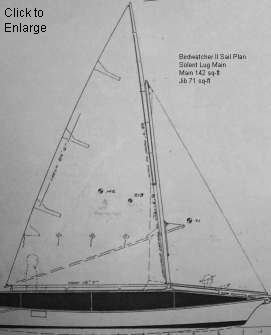 Initial Reactions to Sailing
- 8 Sept 2006, Fern Ridge Reservoir, Oregon. This was the initial trial of the main Solent lug rig. For those not familiar with this rig, enlarge the drawing to the right by clicking the mouse. There is also an article by Bolger on this rig type in Messing About in Boats, 15 Aug 2005, p26, and a second Bolger article, specific to the BW-2, "Birdwatcher with Solent Lug Rig," Messing About in Boats, 1 Oct 2005, p30. The BW-2 has a main mast of 19 feet, 15-1/2 feet of which are above deck. Made from Sitka Spruce, this weighs 33 pounds. This short main mast scheme is wonderful; it goes up and down with ease. This was expressed by Bolger to be of his big driving forces for using the Solent lug. The mast extension, or "yard" is 15 feet total length (mine weighs 11 pounds), with about half of that above the main mast. The main has a luff peak-to-tack of 22-3/4 feet so there are only a few inches below the tack to the deck. The mast makes an angle of 85 degrees with the deck. The main sail area is about 142-square feet.
Initial Reactions to Sailing
- 8 Sept 2006, Fern Ridge Reservoir, Oregon. This was the initial trial of the main Solent lug rig. For those not familiar with this rig, enlarge the drawing to the right by clicking the mouse. There is also an article by Bolger on this rig type in Messing About in Boats, 15 Aug 2005, p26, and a second Bolger article, specific to the BW-2, "Birdwatcher with Solent Lug Rig," Messing About in Boats, 1 Oct 2005, p30. The BW-2 has a main mast of 19 feet, 15-1/2 feet of which are above deck. Made from Sitka Spruce, this weighs 33 pounds. This short main mast scheme is wonderful; it goes up and down with ease. This was expressed by Bolger to be of his big driving forces for using the Solent lug. The mast extension, or "yard" is 15 feet total length (mine weighs 11 pounds), with about half of that above the main mast. The main has a luff peak-to-tack of 22-3/4 feet so there are only a few inches below the tack to the deck. The mast makes an angle of 85 degrees with the deck. The main sail area is about 142-square feet.
When I left the dock in the afternoon, there was a light breeze, and I had no trouble getting the sail up and good tension on the halyard. It looked good, and when I sheeted in the boom it looked even better! A weak front was approaching, and the light wind was from the South, atypical for the summer, but I tacked windward and was moving. The cirrus clouds built and after an hour or so, the wind moved to southwest and built to start creating some white caps. I played with points of sail, and was having a great time. Sailing BW2 has the responsiveness like a big dinghy, and I was surprised how little heel I found. At one point I sheeted in, headed up and tried to get a window under water, but this did not happen, The CB weighs about 160 lb with 110 lb of steel in it. The original BW did not use CB weight. Sailing was really great with this 8 or 10 knot wind.
At this point, I wondered if I might have a problem on my hands with getting the sail down, especially if the wind was to build. So, I released the boom snotter and brought the sail in to the mast as much as possible, with the battens in the sail. Things were flopping about a bit at this point, but no problems. When I released the halyard, it quickly became apparent that big forces were at play. Three issues that made me feel like I was entered in sailboat rodeo were 1-the force on the halyard was too big to handle with one hand, 2-the battens were providing an opening at the top of the sail for the wind, and it wanted to make that opening bigger, and 3-as soon as the halyard was released at all the yard stared flailing about with the lower end coming closer to my head. I used hand number 2 to make the yard safer to me, but could not stop the opening of the sail, and finally gave up and let it go in the water!! I reviewed this mentally, and even though it was my first experience with dousing the Solent lug, it was done about as smoothly as possible for me! Not very smooth, though.
At this wind level, I suspect two people would handle it just fine. Somewhere, perhaps around 15 knots, I think ithe forces would be at capacity for two people. This won't work.
I went back to the sheltered bay at Richardson Park, and reefed the main. By the time I got back out into the middle of the lake, the nearby Eugene Airport was showing 13 and 17 mph (11 to 15 knot) winds. It was nice sailing. I did not feel over powered at all (it would have been fine with the full sail), and the sail above the boom had good shape. It was a bit ugly below the boom, but that is OK. My first tack with the reefed main was too casual and I got whacked by a wave or two and went into irons. I tried tacking several more times with decent speed and the boat swung through smoothly. Again all looked good on the sailing front. So I tried my best to get the reefed sail down smoothly, but it was 1, 2 and 3 all over again. I did keep the sail out of the water, but I was still very concerned about the flailing yard.
I can see helping work-arounds. If someone could operate the motor and keep the boat into the wind, the sail would fall into the boat. An auto-pilot on the tiller might do this as well. Also, a halyard winch is almost a necessity if there is any hope of keeping the halyard taught in a good breeze. The winch would also allow better control in dropping the sail than a simple cleat allows. But, auto-pilots, 3-person crews and winches are all what I hoped would not be needed.
Reduced to basics, I am concerned that there are many conditions where I can sail happily with a sail that I can't get down safely. ---- End of Sept 8, 2006 Notes.
There are a couple of pictures of the Solent Lug, under sail on the early experience page.
Time to Do Something
- By the end of September, there had been a couple more fun sails in light winds and lots of email discussion with the experts. Decisions were made and changes were installed.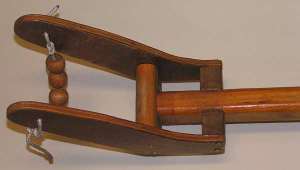
The single biggest change from a safety point-of-view was to add an attachment between the base of the yard and the mast, as shown to the right. This converts the rig to a "Sliding Gunter." This approach was avoided by Bolger, apparently because it involves working the Gunter base around the snotter block on the mast. The picture of the block, below, shows how most of the difficulty was avoided. The wood buildup is gradual, and the jaws of the yard are wide enough that the jaws can come past the block. The jaws pull the snotter line down, but that line is not needed when the yard is down.
The basic design of the 45-degree jaws for the Sliding Gunter was borrowed, with appreciation, from Yorgos Papatheodorou. There is more on this in David Nichols' excellent book, "The Working Guide to Traditional Small-Boat Sails: A How-to Handbook for Builders and Owners."
Other changes were intended to add more heft to raising the halyard, and to speed up this process. These changes include adding three items, a halyard winch, a line clutch above the winch and a 4-part block-and-tackle to the downhaul. The downhaul change allows the sail to be fully raised with only light tension on the luff. After the sail is up, the last step is to pull the luff to the mast with the downhaul
This made the sail handling reasonably safe, and with practice the raising and lowering of the main was working, but sometimes still involving some excitement. One factor not noted in the notes above is the tendency for the boat to position itself with the waves. The boat is narrow, light in weight, and as a result, rapidly positions itself beam to the waves. This means that any bag in the mainsail as goes up or down wants to tip the boat over. In reality, this is mostly an inconvenience. It can be avoided by using the motor to stay headed into the wind. But, this requires a second person, or an autopilot.
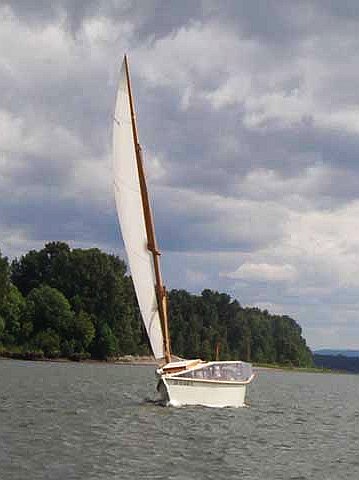
But, let's not forget that the boat is great fun to sail. By the summer of 2007, I was using the jib, when the wind was not strong. The responsiveness of the boat, along with the SA/D around 30, made for great sailing. During the summer, we have modest winds much of the time, and the big sail is the thing. With 2 or 3 people on the boat, the big sail can be used with great happiness most days.
To the left is a picture of the Gunter-modified rig under sail on the lower Columbia River. Thanks to Andrew Linn for this shot.
The Small Main
- I was left with a range of conditions where the Sliding Gunter mainsail was difficult to impossible to handle. Various options were explored, all with the constraint of using the existing mast. Most options that reduced the sail area also moved the center of effort forward, and this pushed for various lug rigs. But in the end, simplicity tended to rule, and the "small main" resulted. This sail is a low aspect ratio main with an area of about 85 sq-ft. As it relates to the big main sail, it corresponds in size to a "second reef." However, I have found it has much more utility than a second reef would have. The geometry of the small main is shown in the adjacent figure, along with the original Solent-lug main.Before discussing the small main further, I would like to digress to my observations on sailing the BW with one and two (plus) people. The most obvious difference is the added balllast. A 150-lb person sitting against the side of the boat has a righting moment of around 300 ft-lb. This is a significant factor when using any of the sails. With a total weight of 1200 to 1500-lb, the moment from form stability, at modest heel, may be 1000 ft-lb or less. But, other factors are involved with one versus two people. The boat is light, and it will head up (sometimes down) very quickly if the tiller is not actively tended. If one tries to leave the helm to go forward to the mast for a few seconds, things will happen. This is true even with the tiller tied off. The second person is an easy solution to this issue. All of this is a non-issue if the winds are below 10 or 15 knots, but at higher winds, a second person makes things much simpler. Remember that the boat sails fine as the wind picks up, but sail handling must be considered.
In general, with the sprit boom and other cleats and "line catchers," it is not unusual to have a line hang up. Maybe this could be improved, but I suspect one should expect to need some walking forward to deal with lines. Some controls such as halyards and the snotter are located at the mast, period.
There are things that can be done to aid single-handed sail handling, such as using the motor and a tiller pilot. I have these available, but it does not seem prudent to rely on them, but rather to use them as a convenience to the extent possible. In this discussion, they are being ignored. On the water, if the wind is blowing strong, I will use them to the extent practical.
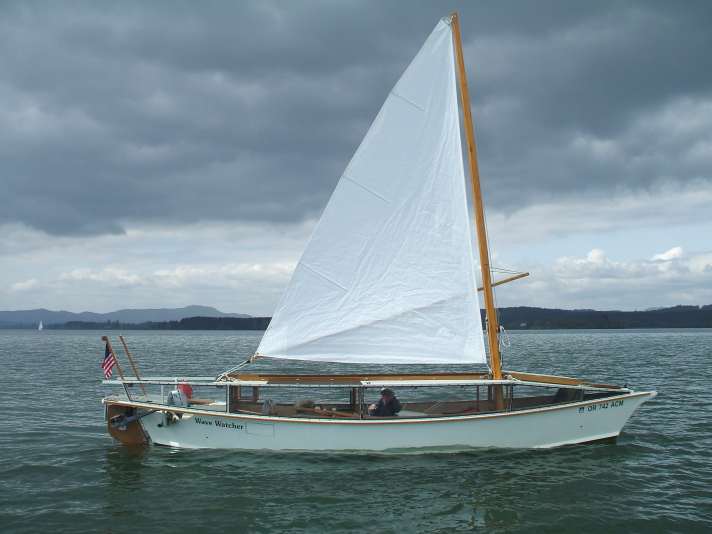 So, how does the small main work out? In the picture above, waiting for the wind to blow, it is pretty casual (I was hunting for a picture of the sail!) So, thinking of times when the wind was helping, and when using the jib, the total sail area is 155 sq-ft, which is a SA/D around 20. This moves the boat well. The small main has no yard weight, and the center of effort is low, so the stability is very noticeably increased over the full sail. Even on a beat, the boat speed is over 4 kts in a 10-12 kt wind, with modest heel of 10 or 15 degrees at the most (one person). On a reach this moves up a knot, or so. Using a whisker pole (I use my extendable boat hook), the wing-and-wing near run is acceptable. With one person and any point of sail, I like the small main plus jib for winds up to 15 kts. The balance of this combination is roughly neutral, but sometimes showing lee helm.
So, how does the small main work out? In the picture above, waiting for the wind to blow, it is pretty casual (I was hunting for a picture of the sail!) So, thinking of times when the wind was helping, and when using the jib, the total sail area is 155 sq-ft, which is a SA/D around 20. This moves the boat well. The small main has no yard weight, and the center of effort is low, so the stability is very noticeably increased over the full sail. Even on a beat, the boat speed is over 4 kts in a 10-12 kt wind, with modest heel of 10 or 15 degrees at the most (one person). On a reach this moves up a knot, or so. Using a whisker pole (I use my extendable boat hook), the wing-and-wing near run is acceptable. With one person and any point of sail, I like the small main plus jib for winds up to 15 kts. The balance of this combination is roughly neutral, but sometimes showing lee helm.
I don't have experience with the small main plus jib, two people and winds over 15 kts. I suspect it would work really well.
In light winds, there is a problem with sail shape for the small main. The weight of the boom alone tends to flatten the sail excessively. In addition, I left the sheet block in the same place as it was for the big main. This causes the sheet to do some flattening, as well. So far, the simplest solution to this has been to add another line (of course!) from the clew of the sail back to the mast at deck level. This restrains the boom from moving aft, leaving more camber in the sail. This makes a huge difference in the windward performance in 5 kts of breeze. It is needed on a reach, but the improvement is less. It might be that shock cord could be used for some of this line, and allow the snotter to be adjusted without needing to play with this compensating line. This is still a work-in-progress.
While still on the use of the small main plus jib in light winds, although the performance is not dazzling, the boat moves easily, and for casual sailing, this simple combination is generally fine for me. Out on the lake, it seems to do as well or better than most "ghosters."
Used without a jib, the small main has an SA/D around 12. This is in the range of a reefed main plus jib for many boats. A while back, I tried to do a careful observation when the wind was reasonably steady and around 10 kts. With care in sail shape and set, I was able to beat at 3 kts or a bit more. The boat was fully upright with me sitting on the windward side. The reaching speed was better. I noticed that on a beat, the speed was better on the bad tack (with the boom against the sail) than on the good one. Maybe this just reflected poor observations, but I tacked several times, and thought it was consistent. Related to this, on the good tack, the top of the sail has more wrinkles related to not being attached to the mast than on the bad tack. The boom is down where the wind is not as strong, so maybe this improved upper shape is a factor. All this, along with the possibility of mast attachment, needs exploring further.
To put numbers to some of this, I used data from a GPS track, taken during a day of variable winds. The sails were the small main and the jib, throughout. Early in the sail, the wind was light, perhaps 4 or 5 kts. The boat moved along at 2 to 3 knots, with me standing in the slot. Later, a weather change came through, and the wind picked up. I sat down against the windward wall of the boat, and headed on a reach. The boat speed was now consistently in the 5.5 to 6 knot range. I have no numbers for the wind speed, but the boat did not heel much and sailing was enjoyable. Unfortunately, that day it only lasted 10 minutes! The message that I got was that the small main can be a reasonable choice, just for an afternoon outing.
The small main alone shows reasonable amounts of weather helm. So far, I have never stalled the rudder, or felt that tiller pull was a problem. The tiller-pilot handles it without problems for all points of sail, as well. But, if the tiller is released, the BW heads up as fast as a dinghy.
Jib
- When Bolger revised the BW to BW-2, among other changes he added the 71 sq-ft jib. Due to the offset mast, the attachment point for the luff is forward of the boat, and this uses a whisker pole. I ended up placing a block where the pole goes forward of the boat, and brought a line back to a cleat where it could be handled from inside the slot. This works adequately for putting the jib up without having to go on the foredeck. I am still fiddling with turning blocks for the jib sheets. These last ended up with one on the starboard edge of the raised deck and one on the port edge of the slot.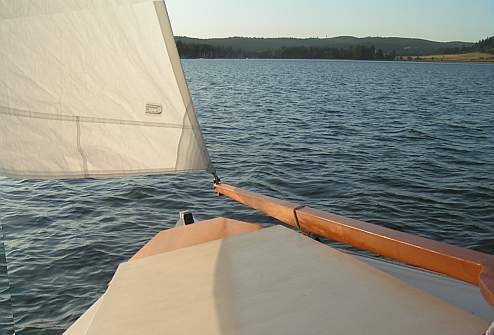 There is an issue of getting sufficient luff tension with the pole. The halyard puts a bit of bend into the pole, and some luff shows up as the wind increases, and is probably not an issue. Lynne put a wire in the luff of the jib. This has a snap shackle to the whisker pole and an ordinary 5/16-inch Dacron jib halyard.
There is an issue of getting sufficient luff tension with the pole. The halyard puts a bit of bend into the pole, and some luff shows up as the wind increases, and is probably not an issue. Lynne put a wire in the luff of the jib. This has a snap shackle to the whisker pole and an ordinary 5/16-inch Dacron jib halyard.
In light air, the addition of the jib makes a big difference. I don't hesitate to use it, since if the wind picks up it is easy to get down. I never use the jib alone, but it would be fun to someday play with a mizzen to work with it.
The boat has some lee helm when using both the small main and jib. This is not desireable, but is not particularly noticeable unless you release the tiller. The reduction of this is in need of more experiments.
Tacking is always interesting, as I have too much assorted hardware on the forward side of the mast. Something, like a jib sheet, often gets hung up, although usually the jib gets around the boom. This is only an annoyance, considering the wind levels that the jib is used. Maybe someday I will address this problem and protect the sheets from the "snaggers" better.
Onward
- As of the winter of 2008-09 this is the sail story. I hope this next season provides me with lots of sailing and maybe some new ideas!
